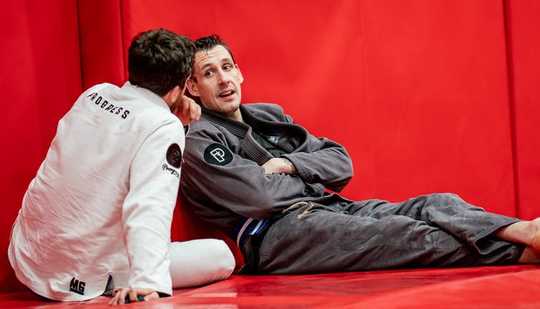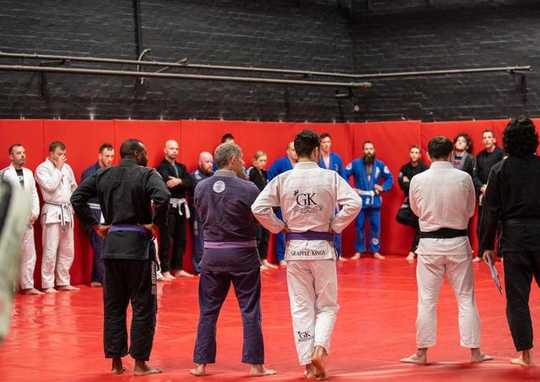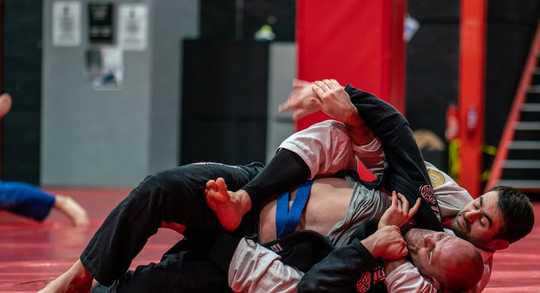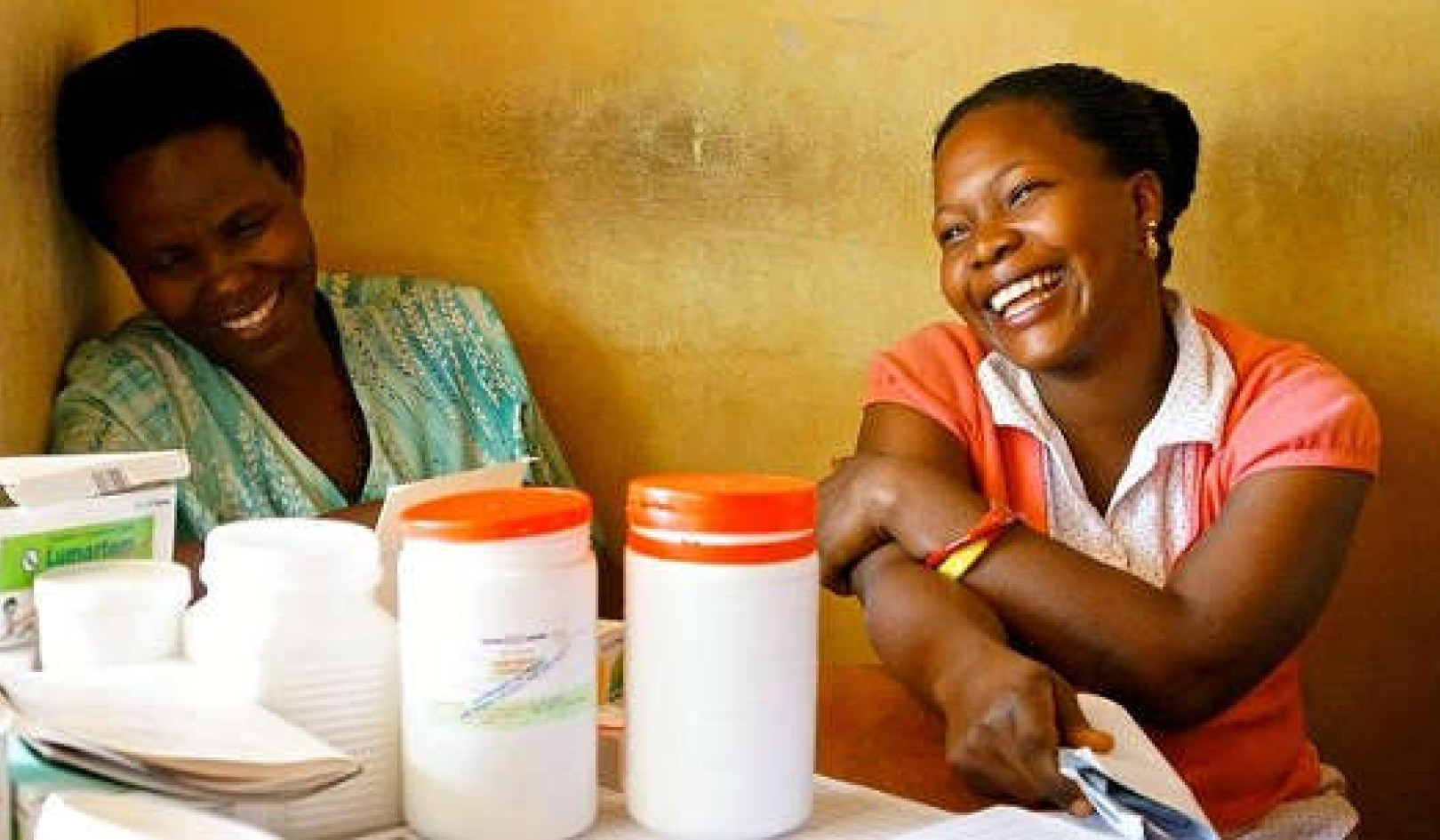 MMA can be far less macho than football or rugby. © Rob Kershaw photography, Author provided
MMA can be far less macho than football or rugby. © Rob Kershaw photography, Author provided
I returned to the UK after a four-year absence to find that the popularity of mixed martial arts (MMA) had increased dramatically. As a physically fit(ish) researcher in the field of sport sociology, I decided to investigate. So for the last two and a half years, I have trained, fought, socialised and competed with other members of an urban MMA gym in the north west of England. Training between four to eight hours a week, every week, I entered this world expecting a fight for acceptance in a dog-eat-dog enclave of hyper masculine brutality. I was wrong.
The UK was home to 12 MMA gyms 11 years ago; today there are 320. The growth in participants has been matched by spikes in fandom, attendances at live events and growing interest from mainstream media outlets and sponsors. Packaged and sold as a violent, bloody and transgressive sport, MMA has been the target of many critiques as both a sport and spectacle. Fights can be brutal, as are the training regimes which, even for amateurs, put significant demands on the body, wallets and time of gym members. So why are people – mainly men, but growing numbers of women too – putting themselves through this?
On first entering the gym it was the smell that hit first: sweat thinly veiled by incense burning at the reception area’s makeshift café. Then the sound: music booming, from The Stone Roses to minimal techno, shouts punctuated by the thwack of pads absorbing impacts of jabs and kicks. Then the sight: 20 to 50 men, women and children at work, sparring in the cage at the centre of the gym, rolling on the mats around it. I didn’t know it then but this messy ecosystem, mixed by design, was to become a necessary home away from home.
 A class in session. © Rob Kershaw photography, Author provided
A class in session. © Rob Kershaw photography, Author provided
My early diary entries are full of observations confounding initial expectations. As a lifelong football and rugby enthusiast, with a record of in-depth investigation into these sporting worlds, I was amazed to find the gym to be far friendlier than those sub-cultures. And it was much more socio-economically diverse – doctors, scaffolders, lawyers, taxi drivers, and those who make a more spurious living, form close bonds through the shared growth and torment that typifies MMA.
Many of these bonds were formed through the practice of jiu-jitsu, which occupies the centre of this mixed ecosystem.
The gentle art
A proficient MMA fighter needs to become skilled in several key disciplines. But since Royce Gracie won the first Ultimate Fighting Championship (UFC) in 1993, employing jiu-jitsu to defeat stronger and larger opponents, jiu-jitsu has become both fundamental to the house of MMA, and a fast-growing sport in its own right.
Originating in Japan, jiu-jitsu, which roughly translates as “the gentle art”, requires you to redirect your opponent’s force, taking them to the ground, where you battle to submit them through a multitude of chokes and limb locks. Unlike other martial arts, such as karate or taekwondo, aggression is discouraged. Yet, jiu-jitsu is an indispensable discipline in MMA, with many gyms making it a focus. A large amount of professional MMA bouts end in submission. My gym was no different, with jiu-jitsu sparring and instruction dominating the mats.
But rather than the fight I was expecting, jiu-jitsu can be a mindful practise likened to chess, a game of which is often in progress in the reception area. This “cerebral” element of jiu-jitsu is a central aspect of MMA that is rarely portrayed in the way the sport is packaged by much mainstream media.
 Seeking submission. © Rob Kershaw photography, Author provided
Seeking submission. © Rob Kershaw photography, Author provided
It is also difficult to grasp in the early stages of training, when the drive home often meant fighting back tears of frustration, pain or both. But with perseverance comes reward. Frequent defeats on the mats are lessons learned and passed down from more experienced partners. The following reflection was typical:
I pin my chin against my chest to hold off his choking arm, but he readjusts and it slips under … I pull at it futilely, but he arches his back, and squeezes … am I done?? … can’t breathe and vision starts to go … I’m done, I tap and he lets go immediately. We bump fists, breathing heavily, ‘nice’ he says ‘you could have prevented that though … come here let me show you’.
Such scenarios can be profoundly uncomfortable and extremely stressful yet happen in various forms several times a session, over several sessions a week. Success is found in remaining calm, controlling your breathing and thinking carefully, clearly and quickly. Such practice had a significant impact on my life outside of the gym.
A mental fight
After a year of regular training I felt I knew enough to sit down with experienced competitors to ask why they committed so much to the gym. One told me that he missed his daughter’s first steps because he wanted to get better at jiu-jitsu. But he went on to say that he trained largely for mental health reasons, often at the expense of his physical health due to injury.
Connor, who oversees the gym induction process, had similar ideas. “No-one ever wants to tell you the main reason [for joining],” he said. “They’ll say it’s about fitness or it’s about a hobby but deep down it can be about something else.” It became clear that the “something else” tended to be more cognitive than physical. The fight against stress, anxiety, depression is greater than the threats from physical opponents. Simon admitted that training was “an important outlet for a lot of people and for a long time I didn’t realise quite how much of an outlet it was”. Neither did I.
The consistent training, the testing of oneself against another and the many defeats in sparring mean a very personal confrontation with yourself and ego. It takes a lot to try and it takes even more to get beaten again (often by smaller opponents) and to try again. This dynamic equips you with mental resilience and a calm under pressure that I have never known.
There is a paradox here. Stereotypes around masculinity are said to be a barrier to “mental health literacy” and help-seeking for sufferers. Yet in learning to fight, it seems that some participants are fighting off real threats to their mental wellbeing.
The gym is not a wellness retreat. Significant injury is commonplace, yet up and down the country people have signed up in their droves. I no longer ask why people put themselves through such a training regime, but I do wonder: what kind of society makes such a choice worthwhile?![]()
About The Author
Jack Sugden, Lecturer in Sport Development, Management and Sociology, Edge Hill University
This article is republished from The Conversation under a Creative Commons license. Read the original article.
Books on Fitness and Exercise from Amazon's Best Sellers list
The Four-Pack Revolution: How You Can Aim Lower, Cheat on Your Diet, and Still Lose Weight and Keep It Off
by Chael Sonnen and Ryan Parsons
The Four-Pack Revolution presents a total-life approach for attaining health and fitness goals without the hard work and suffering.
Click for more info or to order
Bigger Leaner Stronger: The Simple Science of Building the Ultimate Male Body
by Michael Matthews
If you want to build muscle, lose fat, and look great as quickly as possible without steroids, good genetics, or wasting ridiculous amounts of time in the gym and money on supplements, then you want to read this book.
Click for more info or to order
The Women's Health Big Book of Exercises: Four Weeks to a Leaner, Sexier, Healthier You!
by Adam Campbell
The Women's Health Big Book of Exercises is the essential workout guide for anyone who wants a better body. As the most comprehensive collection of exercises ever created, this book is a body-shaping power tool for both beginners and longtime fitness buffs alike.
Click for more info or to order
Bodyweight Strength Training Anatomy
by Bret Contreras
In Bodyweight Strength Training Anatomy, author and renowned trainer Bret Contreras has created the authoritative resource for increasing total-body strength without the need for free weights, fitness machines, or even a gym.
Click for more info or to order
The Men's Health Big Book of Exercises: Four Weeks to a Leaner, Stronger, More Muscular You!
by Adam Campbell
The Men's Health Big Book of Exercises is the essential workout guide for anyone who wants a better body. As the most comprehensive collection of exercises ever created, this book is a body-shaping power tool for both beginners and longtime fitness buffs alike.

























